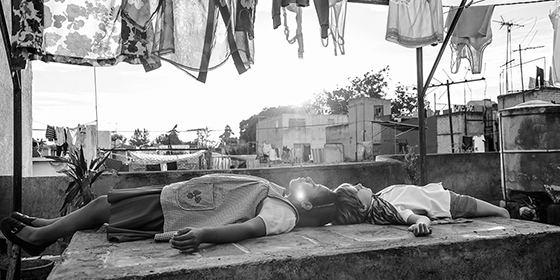Roma

Photo courtesy TIFF.
You know what the Mexicans say about the Pacific? They say it has no memory. That’s where I want to live the rest of my life. A warm place with no memory.
– Stephen King, Different Seasons
Not connected to Fellini’s ROMA, this picture is a spiritual descendant of his semi-biographical AMARCORD. It reminisces on various elements of director Alfonso Cuarón’s childhood, including—briefly—the 1969 film MAROONED (he cast Clooney in the Peck role in GRAVITY), peppering in themes and imagery from 8 1/2 and LA STRADA. The director, whose own childhood bears a passing resemblance, manifests himself (as all directors eventually self-insert) in the form of a little boy whose pastime of make-believe proves he may someday make a great storyteller.
Cleo (Yalitza Aparicio, an unknown whose stunning performance shines with humanity and warmth), servant to a medical doctor and his estranged wife, Sofia (Marina de Tavira), discovers she is pregnant. Upon hearing the news, her martial arts-obsessed boyfriend Fermin (Jorge Antonio Guerrero) disappears.
In 1968, student resistance movements erupted, pushing back in opposition against various authoritarian regimes around the world. Mexico was no exception. Symbols of authoritarianism abound in the Roma district of Mexico City. There’s a marching band, made up of young conscripts, and somewhere on a bluff overlooking Aeropuerto Internacional de la Ciudad de México, Professor Zovek (Victor “Latin Lover” Ruiz) gives motivational speeches to trainees. We later discover the reason for their training.
Throughout the film, Cuarón’s cinematography and editing tells a story of isolation and subordination—women and men framed and shot separately. The doctor, a sparse presence we rarely see except in glances, absconds with his mistress despite telling his family that he’s held up in a research project in Quebec. Stumbling drunkenly out of her husband’s excessively large Ford, facing mounting bills at home, Sofia tells Cleo, “Women are always alone.”
Cleo’s water breaks in June of 1971 during the Corpus Christi Massacre, during which the government slashed the public university budget just as France shuttered the Cinémathèque Française three years earlier. As in his dystopian science fiction, CHILDREN OF MEN, Cuarón demonstrates an instinctive application of the visual medium.
Whereas most filmmakers employ the Rule of Thirds across the horizontal and vertical axes of the frame, the greatest cinematographers—from Toland to Deakins—work in thirds through the depth of the shot as well. Whether surveying the carnage of the revolt, or observing in the operating room where Cleo is giving birth, Cuarón balances his juxtapositions seamlessly. Your brain absorbs the foreground and background layers of the narrative even if you consciously didn’t.
Like the closing scene of Fellini’s 8 1/2, bookending ROMA are shots of water washing away Cleo’s transgressions. These images, along with the theme of childbirth (water breaking), resonate as leitmotif: As the sacrament of Baptism is a rebirth for Catholics, in ROMA from water we emerge, cleansed twice of our sins.